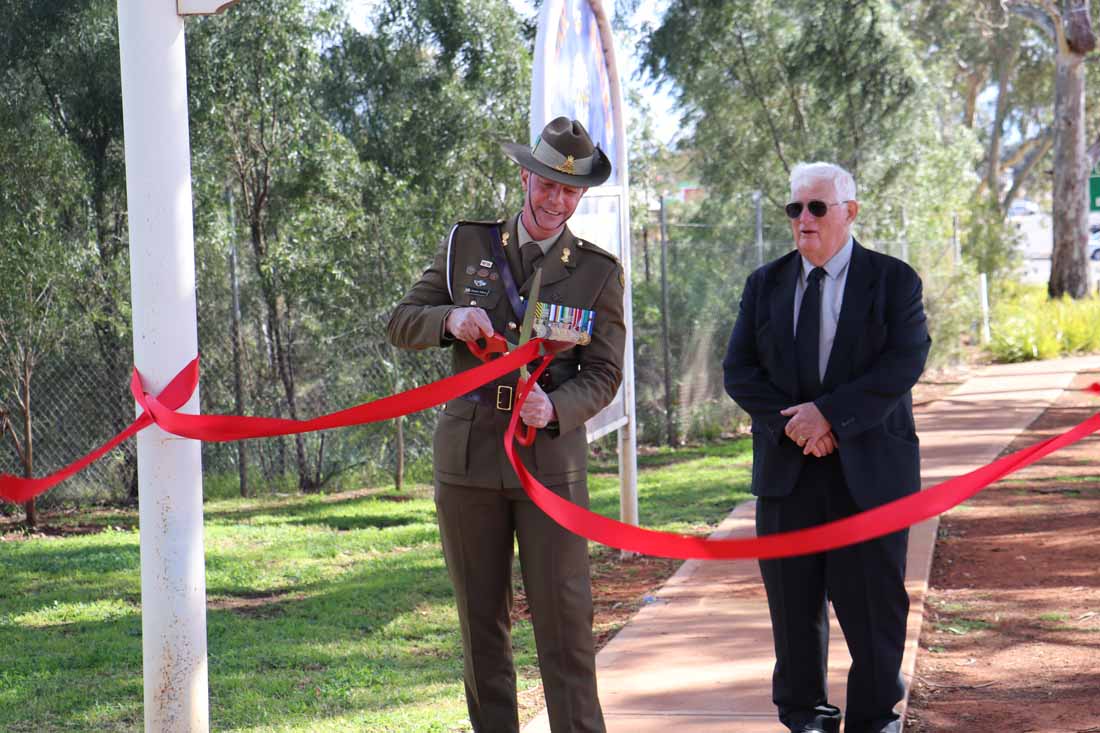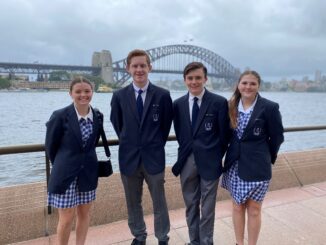
Cobar’s newly installed Poppy Fence on the Open Cut, which pays tribute to the 600 people (approximately) from Cobar who enlisted to serve in World War I, was offi-cially opened on Saturday.
The idea for the fence came from locals Bar-ry and Ginny Knight with Barry the driving force behind the project.
With support from Manuka Resources, Aure-lia Metals and the Rotary Club of Cobar, the fence was recently installed with Major Mat-thew Sullivan from the Australian Army (Barry’s nephew) invited to officially open the fence.
Major Sullivan said it was an honour to join the Cobar RSL Sub Branch and broader Cobar community at the opening.
He said the Poppy Fence, realises the vision of honouring the men and women who have served in all military conflicts.
“Particularly those Cobar miners of the 1st World War, who made ideal ‘Sappers’, join-ing the Tunnelling Companies of the Australi-an Mining Corps of the Royal Australian Engi-neers,” Major Sullivan said.
He explained the Tunnelling Companies conducted offensive and defensive mining operations which involved digging and main-taining mines under enemy placements often in darkness and silence, to then explode those mines just prior to large advances by the Aus-tralian Infantry.
Sappers were also responsible for a range of other underground work, digging trenches, underground chambers for signals and medical services, building roads, bridges and infra-structure to support broader allied operations.
“Following the devastation of WW1, memo-rials became commonplace throughout Aus-tralia in communities large and small com-memorating the millions who had served and given so much for their country.
“These memorials are places of reflection, where communities can gather to mourn or pay respects,” Major Sullivan said.
“Memorials continue to be an expression of remembrance, loss, grief and pride, and recog-nise Australia’s involvement in wartime opera-tions, peacekeeping and service to Australia.
“Therefore, as we gather today, in the vicini-ty of this magnificent Poppy Fence we pause to recall those men and women of the Cobar community who served in war and particularly those who did not return to receive the grateful thanks of our nation.”
Major Sullivan recounted some of the Cobar servicemen and women’s stories from World War 1. Major Sullivan recounted the stories of some
of the Cobar community members that served
in World War 1:
Arthur and James Renshall were two sappers
from Cobar, brothers, who took part in the
famous Hill 60 campaign on the Western
Front. They joined up in late 1915 and were
with the 1st Australian Tunnelling Company.
In France, the Renshall brothers spent
months creating and guarding galleries under
the strategically vital Hill 60. However, neither
brother saw the successful completion of
the campaign.
Both men were working on a sap (trench
system) near the front lines when heavy
shelling and an enemy advance saw that area
overrun. Initially, reported missing in action
the brothers were later confirmed captured as
prisoners of war.
Sadly, Arthur succumbed to wounds received
during this action and James was repatriated
back to Australia after the war.
Richard Slingsby, was a mate of James
Renshall, and had worked with James around
Cobar before the war. They joined up at the
same time, with Richard also joining the 1st
Australian Tunnelling Company. For his actions
during the war, Richard was decorated
with the Military Medal.
Charles Mackenzie was the manager of the
combined Tinto and CSA mines and then the
Occidental.
Charles was experienced in all aspects of
mine engineering. He enlisted in 1916 and
became a sapper. After rising quickly in rank
and having completed an officer’s course,
Charles was then attached to the British 250th
Tunnelling Company, Royal Engineers. At
war’s end, Charles was a lieutenant and decorated
with the Military Cross for his actions in
voluntarily defusing a bomb at the Lille Railway
Station, France in 1918.
Charles Mackenzie, MC repatriated to Australia
at the conclusion of the war, returning to
Wrightville, where the community presented
him with an engraved watch ‘as a mark of
esteem’.
But not all those who served were miners
and sappers such as Sister Stella Broadhead.
At the outbreak of WW1 Sister Broadhead
was the matron of the Cobar District Hospital,
having been appointed in 1912.
A vastly experienced nurse, in 1915 Matron
Broadhead applied for leave from the Hospital
Committee to enlist in the Australian Army
Nursing Service. Sister Broadhead spent the
next three and a half years nursing in the field
hospitals of the Middle East, Europe and on
hospital transport ships.
Having initially joined as nursing staff, Sister
Broadhead was later promoted to sister
within the nursing service. On repatriation to
Australia Sister Broadhead resumed her duties
at the Cobar District Hospital, where she remained
until 1921.


